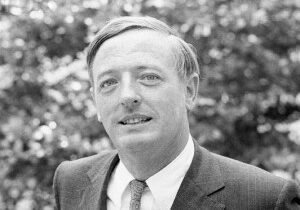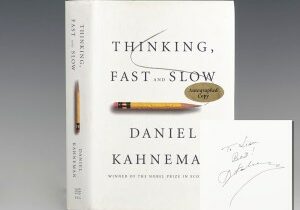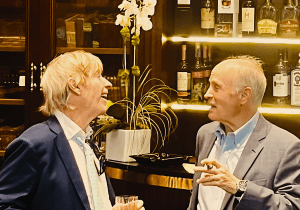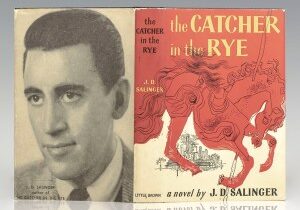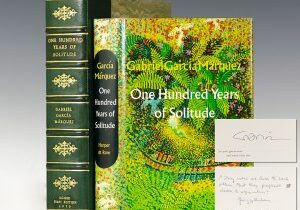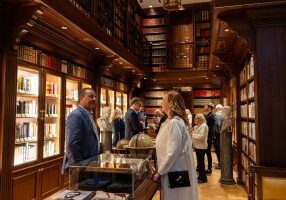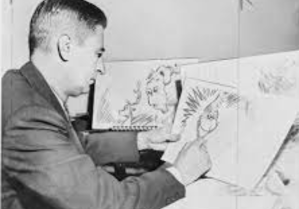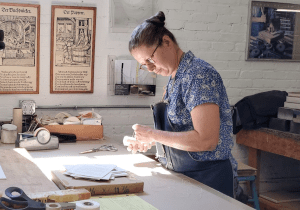I was going to write a few thoughts on collecting photography books, but I believe that Mike Johnston on photo.net summarized it extremely well. If you are new to collecting or to collecting photography books, this is a wonderful article to read and I have copied part of it here:
Photography books are arguably one of the two best types of books to collect today (the other is first editions of modern fiction). New photo books constitute original artwork — in many cases the first “lasting public record” of significant work. They are often beautiful physical objects, with nice reproductions, paper, printing, and design. Although they often become scarce almost immediately, good books from the recent past are still floating around out there waiting to be discovered by the determined or lucky collector on used-bookstore shelves. And even some of the major treasures of the past are still available to the private buyer, having not yet been priced entirely out of reach. Good taste is rewarded, and knowledge can go a long way in identifying important books.
But the main reason photo books are so collectable is simply that almost all photography books have low printing runs and are seldom reprinted. Here’s the approximate progression of a typical photography book’s commercial life:
1. Newly released, available in bookstores for full price. Not available everywhere, but readily available if you keep up with your sources.
2. Remaindered or sold on sale. Seems like nobody wants it. Book is common and cheap at this point.
3. Book is out of print; remainders are gone; book starts to get harder to find.
4. Most copies have gone into libraries or private hands; book is scarce, found mostly on the used / rare market; value rises. If it’s a good book, the value can rise quite a lot.
When first published, and especially if they’re remaindered, photo books can be cheap to acquire. But because they become scarce so quickly, their value is dynamic over relatively short periods of time. This really enlivens the hobby of collecting them. The “problem” for the producers of these books is that the demand is low but steady. So the demand isn’t great enough to soak up a big printing all at once, yet the demand never really goes down, so as the printing run slowly gets consumed, the relative demand for the increasingly scarce remaining copies tends to keep going up.
Of course it has a lot to do with the quality and intrinsic worth of the book in the first place.
| Paul Outerbridge’s 1940 instructional book Photographing in Color is desirable because it contains tipped-in reproductions of some of his own color pictures. Incidentally, one reason why Outerbridge’s carefully-crafted original carbro prints are so rare is that, after his death, his thoroughly middlebrow wife destroyed many of his nudes and fetish pictures because she was afraid they would “damage his reputation”! With friends like that…. |
Rarities and reprints
Let’s look at a few concrete examples. William Eggleston and John Szarkowski’s famous William Eggleston’s Guide was published in 1976. By the late ’70s, one of my dealers remembers seeing stacks of them at bookstores in NYC remaindered for $5 each. By the time I bought mine, in about 1983 or ’84, I paid $30 for a used copy. Now it’s about a $250-$300 book and that’s assuming you can find one at all.
William Eggleston’s Guide was just reprinted. Okay, now you could be excused for thinking that the reprint is undesirable and that the first edition is preferable. While that is true to a certain extent, the reprint will also become valuable in the future, for the very same reason the original is valuable. It will go through the same four steps I detailed above.
A recent reprint I missed (to my everlasting chagrin) was the 1997 Twin Palms reprint of Danny Lyon’s famous book The Bikeriders, pictures he took when he was a member of a motorcycle gang. (Significantly, part of the reason for this book’s rarity is because it is not only considered collectible by photography buffs — motorcycling aficionados also want it!) Jack Woody’s Twin Palms Press is a premier book producer, known for superlative reproductions. Although I saw the Lyon book on the shelves at Borders in ’97 and knew I should buy it, I must have been short on pocket cash at the time — I passed it up. Bad decision! Now it’s out of print, all the copies have vanished, and it’s already a $150 book on the used-book market. And all in six measly years!
So reprints can be good buys too. I couldn’t afford an original edition of Robert Frank’s The Americans when I started getting interested in photography in 1980, but eventually I bought a very clean copy of the 1986 Pantheon reprint. My version of this landmark book sold new for $35; I bought it remaindered for half price. It’s now valued on the used market at above its original selling price. That’s a modest increase, to be sure, but it’s been a nice version of the book to own and enjoy.
Other reprints have proven more valuable. The 1978 Aperture reprint of The Americans can go for up to $300 (there’s a rare signed copy for sale right now at Time and Again Books in NYC for $3,000. Same book, but the signature is worth $2,700. The reclusive Frank was never big on book signings). Even the 1994 Scalo reprint is a $50-$60 book now — and it’s a paperback!
Here’s a typical catalog entry for the real first edition of the book (unsigned). Note the price. Note also that it’s not only not a perfect copy, it’s actually been repaired.
FRANK, Robert Robert Frank: Les Américains (The Americans) Paris: Delpire. 1958. True first edition (French). Illustrated laminated paper-covered boards (illustrated by Saul Steinberg), no dust jacket as issued. Photographs by Robert Frank. Text (in French) by Alain Bosquet. Edited by Robert Delpire. 174 pp. with 85 b/w plates. 7 1/2 x 8 3/8 inches. Very Good+ to Near Fine (bump to boards at lower right hand corner, some wear to crown and base of spine, slight shelf wear to covers, all pages Fine). Binding professionally repaired (scans of the covers, and a copy of the conservation report and invoice, available upon request). Also includes a copy of the sole owner’s original Wittenborn and Company receipt from 1964 (small Wittenborn sticker affixed to rear paste-down endpaper). ISBN 2851070088. Bookseller Inventory #B0012 Price: US$ 2750.00 Bookseller: Vincent Borrelli, Bookseller, Albuquerque, NM, U.S.A.
This seems out of reach, and maybe it is — now. But remember that the book was widely panned on its release (it was printed in France because no American publisher wanted it) and copies went begging for a number of years after it appeared. The collectors who recognized the book’s importance at the time got themselves a rare book indeed, as well as one that has turned out to be, among other things, a good investment.
| One minor problem with collecting photography books is, to paraphrase Quint in Peter Benchley’s Jaws, “We’re gonna need a bigger bookshelf.” My largest book is eighteen inches wide. |
Knowledge and taste
Now, not every photo book is a first edition Frank. But another facet of the hobby is that, if you know that the Delpire edition of the book is worth three grand or more, you’re prepared if you ever run into it when you’re book-hunting. You probably won’t get lucky and find that particular book, unless (maybe) you live in France. But believe me, books this valuable and more so are found every day by book-hunters who pay pennies on the dollar for them. The key is simply to know what you’re looking at when you come across things. I regularly make “finds,” for instance, getting books for a few dollars that are much more valuable than that. How? It’s simple; knowledge. If I don’t know a book’s significance, I can sometime guess (after a while, you just start to get a sort of sixth sense about things). Virtually every used and rare book dealer has a story of his or her best “find,” an occasion when they bought a book for $2 or $20 that was worth thousands, tens of thousands, or even hundreds of thousands of dollars. If you doubt me, go to your local used / rare bookstore owner and ask!
This knowledge — knowing what you’re looking at when you see something — begins to accrue when you buy your first good book. And as Pulitzer-prizewinning author and book dealer Larry McMurtry says in one of his essays, there is no natural endpoint for your acquisition of knowledge other than the obvious one. You can keep learning more all your life.
I bought a copy of the Calloway Alfred Steiglitz for $30 remaindered. It was printed by the National Gallery of Art after Georgia O’Keefe choose the National Gallery as the repository for her Steiglitz collection. As you probably know, Miss O’Keefe was Steiglitz’s lover and the subject of many of his pictures. I plucked it off a stack of remainder copies sitting on a bookshop floor that came up to my knee. It’s now a $400 book. It was also recently reprinted — and the reprint is now remaindered. If you want it, get one while you can
Some books are instantly recognizable. I found my copy of Cartier-Bresson’s The Decisive Moment in my grandmother’s library after she died. She collected books on France, mostly on cooking, travel, and royalty, but somebody had given this to her as a gift and the photos were probably not to her liking. She didn’t even display it with her good books out on the shelves — and it was hidden away in a cabinet with a bunch of discards, old papers, duplicate copies, and other junk. It was in nearly perfect condition — it had essentially never been looked at. It’s maybe a $2,000 book in this condition. Granted, this doesn’t exactly count as a “find,” because I found it in a relative’s house and simply asked my grandmother’s direct heir (a.k.a. “Mom”) if I could have it. But it’s a major book that has never been reprinted (if it ever is reprinted, snap one up). I’m naturally pleased to have it. It’s the best book I own.
Here’s the bottom line. If you know what’s important and can tell a well-made book from a bad one, and know which books reproduce the artist’s work well (this requires going to museum shows and seeing what the original prints really look like — for instance, virtually none of the many books of August Sander’s work really reproduce the look of his original prints), and you collect the kind of photography books you personally know most about and enjoy, chances are very good that in a relatively short time you will amass a rich, varied, and virtually irreplaceable collection.
Where to start?
You should never buy anything because someone tells you to, however. One of the main reasons to collect anything is to express yourself, to express your own personal interests and your vision for your own collection. Collectors collect things because the objects of their desire delight them. As with anything else, the main principle of collecting photo books is simply to make sure you never buy a book you don’t truly like. If you enjoy owning what you buy, then no purchase can ever really be a bad one.
That said, what’s a good place to start? Well, from my point of view, I think the current reprint of the Szarkowski book I mentioned above is an excellent one to buy right now (it’s a book I happen to love, so maybe I’m prejudiced). Another new book I think is beautiful and will be valuable in the future is Helen Levitt’s Crosstown. Miss Levitt is still living, but she is aged, and this may be the last major retrospective printed in her lifetime. Crosstown is an outstanding collection of her life’s work; the reproductions are well done and sensitively chosen. The book is beautifully designed, printed, and made. It has an unusual light gray cloth binding with crisp dark gray stampings — no dust jacket — and it’s limited to an edition of 6000 copies. The first printing is still available from Amazon.com for less than $60. I can virtually guarantee that this is a book that ten years from now, and twenty years from now, and thirty years from now, will be worth many times its original price.

| Photography books can be beautiful examples of the bookmaker’s craft. Phaidon’s gorgeous Crosstownhas a light gray cloth binding with dark gray stampings, and no dust jacket. |
Even if you just buy new books, you can build a valuable collection in a relatively short amount of time if you choose wisely — photography books don’t take a hundred years to become rare and valuable. Some can become so in as little as five or ten years; in twenty or thirty years, most good photography monographs will have satisfied the definition of a collectable book: “worth more used than it sold for new.” Obviously, if you add remainders and used books to your shopping list, the opportunities for building a nice collection for relatively little money expand even more.
Finally, if you buy books you genuinely like (I wouldn’t counsel doing anything but!), it doesn’t matter if they increase in value or not. I have more than a few books (Alice Springs’ book of portraits, The exhibition catalog American Photographs from the National Gallery of American Art, Eric Newby’s What the Traveler Saw) that I love even though they’re not well-known or valuable. Why? I like the pictures, of course!
I highly recommend starting a photo book collection if the idea appeals to you. It can deepen your knowledge of, and your enjoyment of, photography; it can express your personal taste; and it can be fun. Even if you buy no more than a dozen well-chosen books a year, in a decade or two you will have gathered a respectable, and probably valuable, collection. As far as starting a library goes, none of us are going to be Henry Clay Folger. The golden age of book collecting is long gone. But even a handful of carefully chosen photo books can become the nucleus of a very enjoyable and enriching personal collection.
— Mike Johnston




